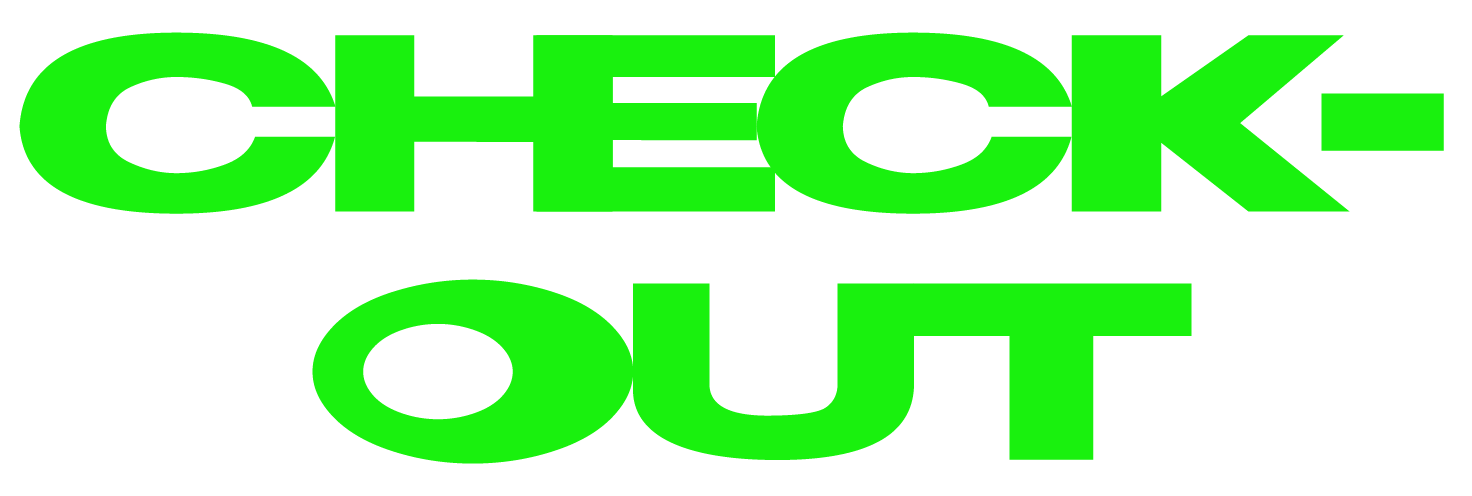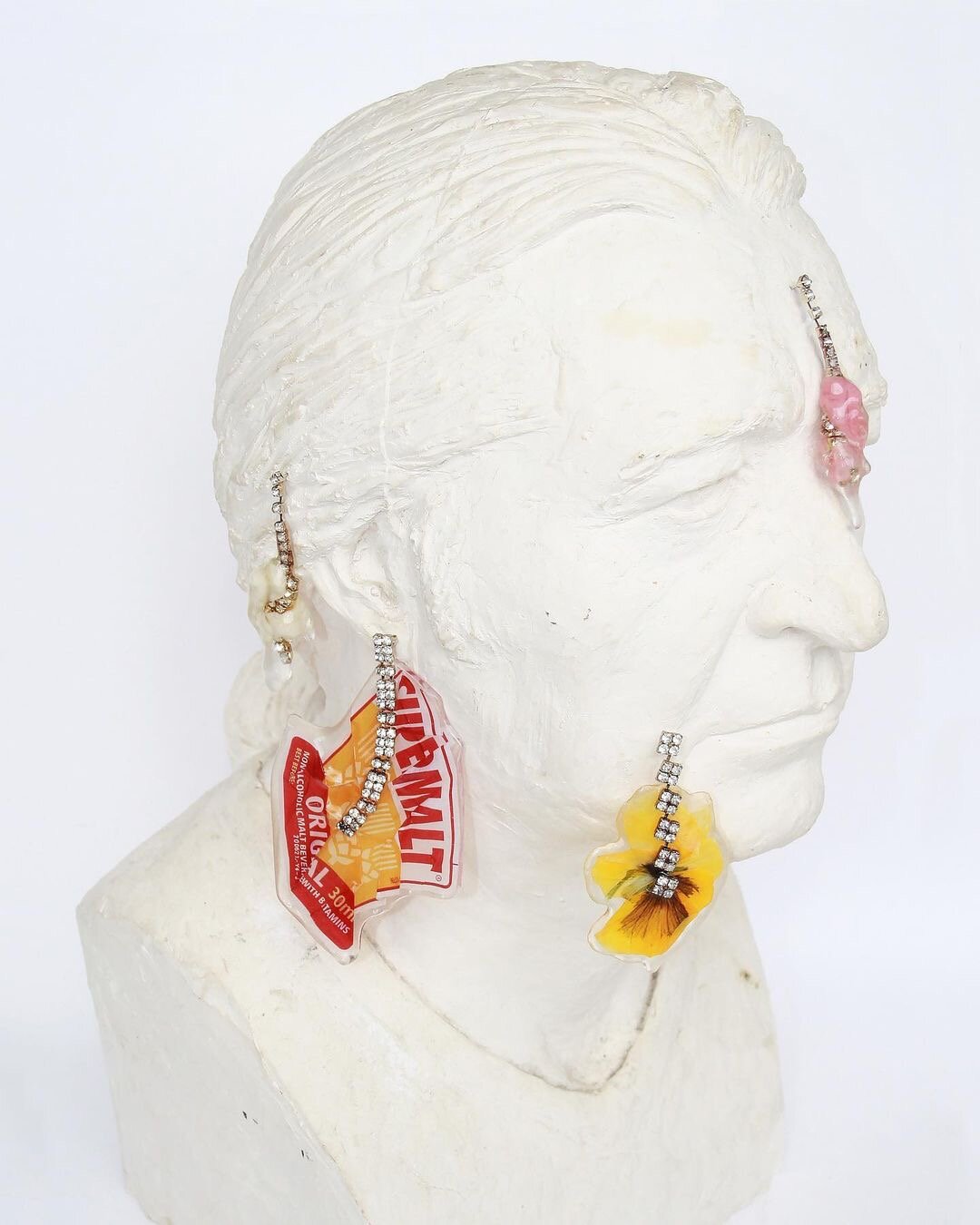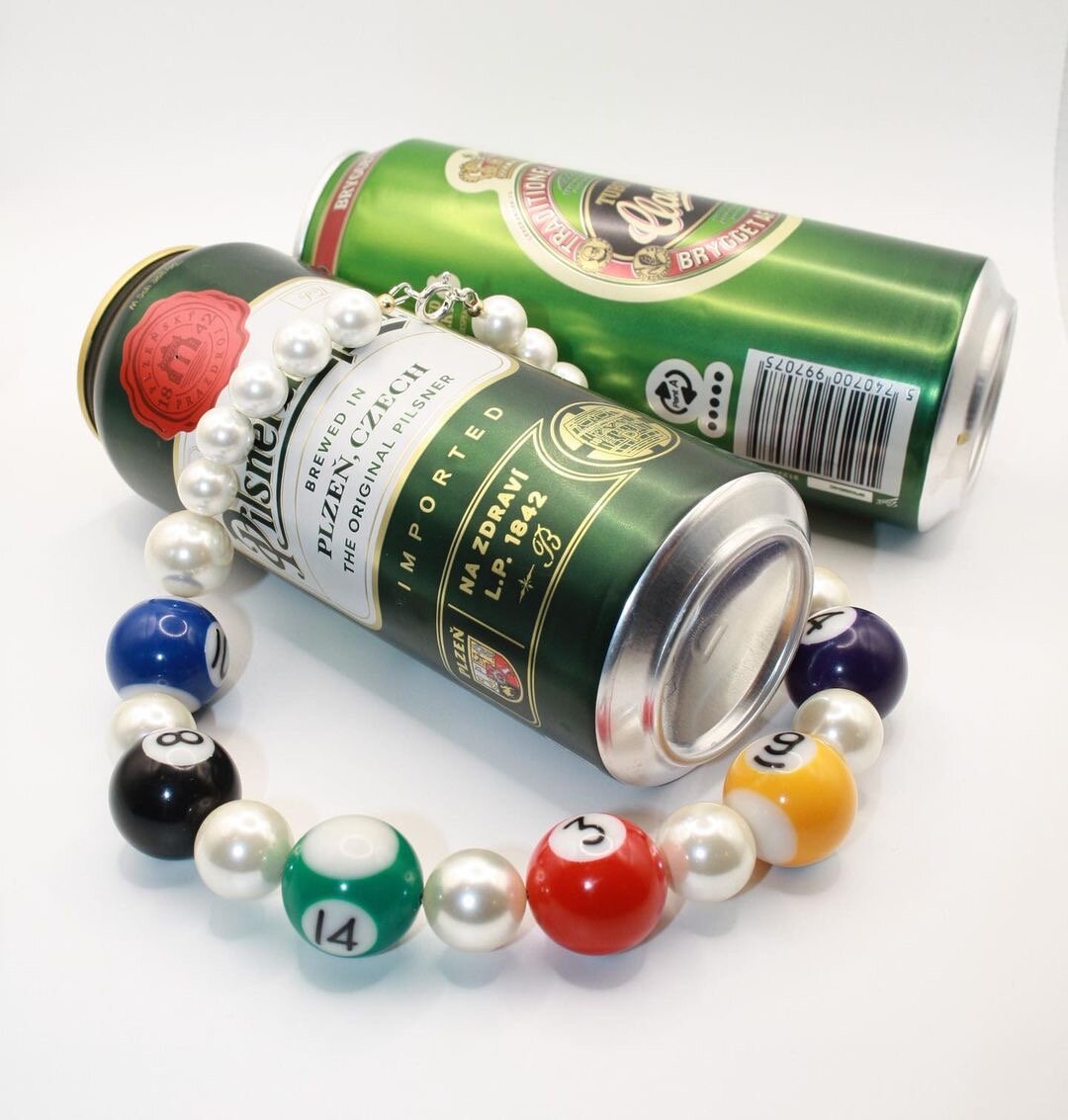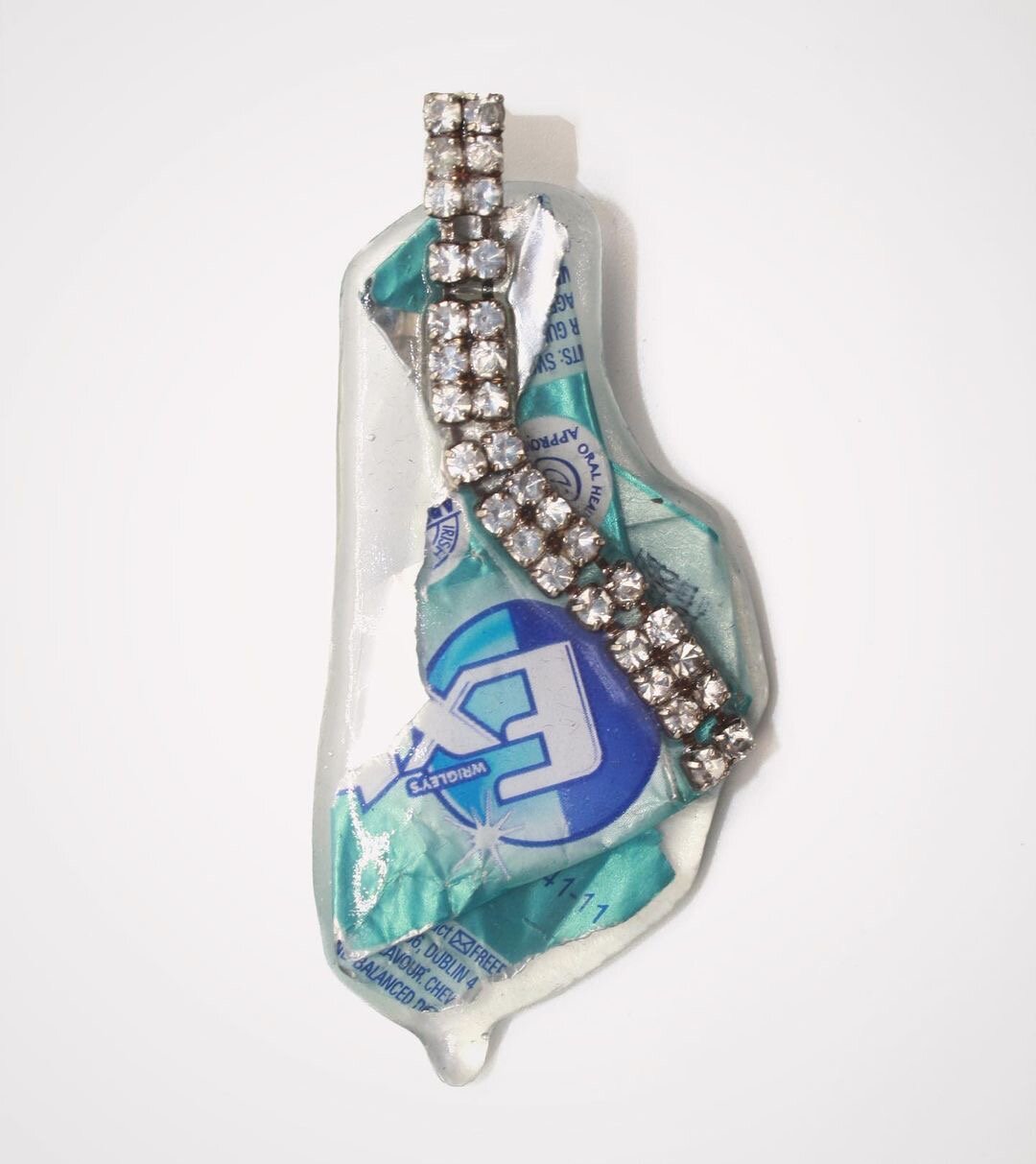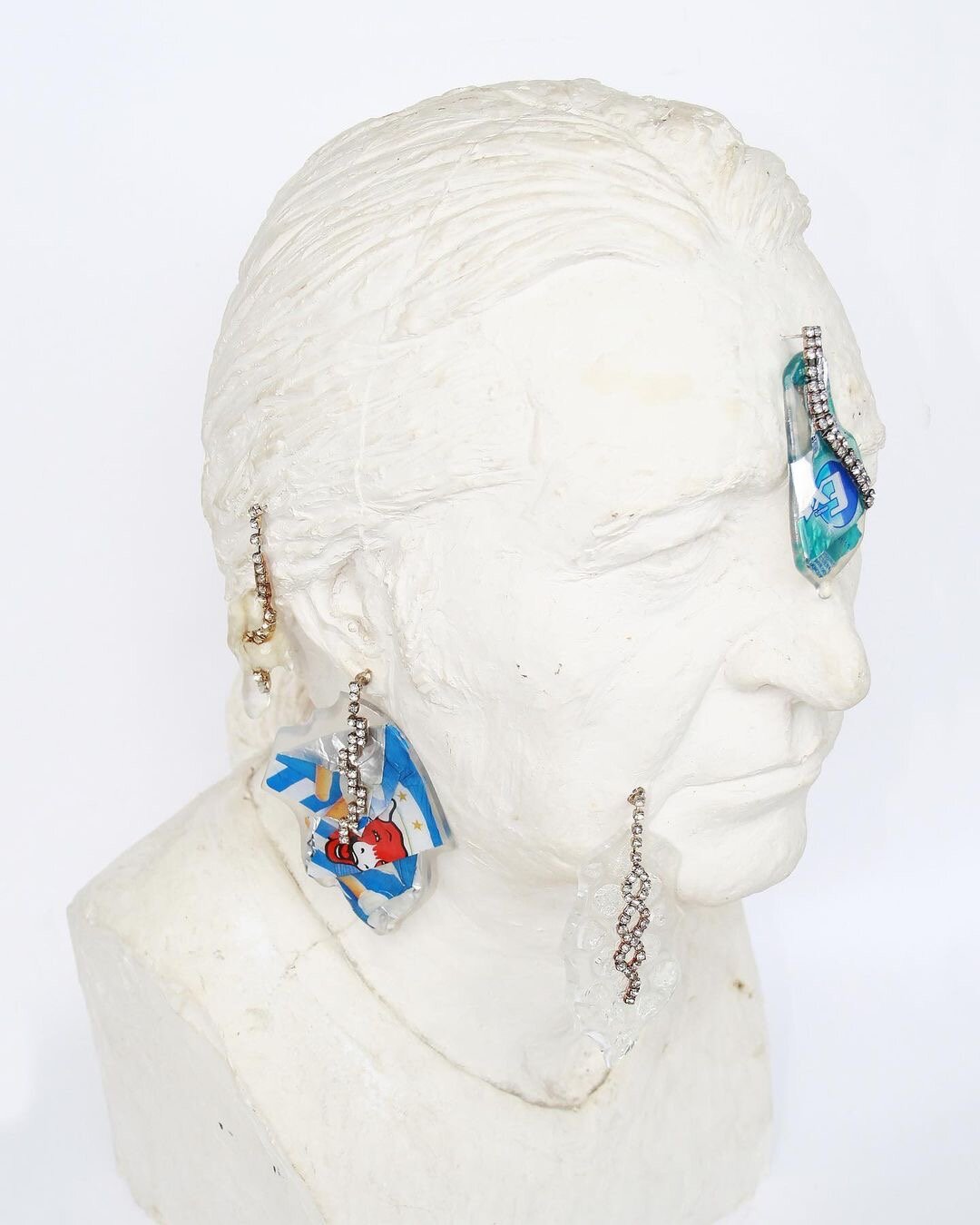Ashtray brooches and Supermalt earrings: Caroline Ohrt turns waste into wonders
This is A HOT MINUTE WITH, a quick-fire interview series championing all the rising talent catapulting into fashion, art and music’s fickle stratosphere. From pinch-me moments to bad dates and even worse chat-up lines, think of it as an overindulgent conversation – like the ones you have in sticky club toilets at 4.A.M. Except these guests don’t regret the overshare…
Courtesy of @caroline.ohrt
NAME CAROLINE OHRT
AGE 29
LOCATION Copenhagen
STAR SIGN Leo
MOST USED EMOJI Fire emoji 🔥
If you’re stuck in your jewellery ways, Caroline Ohrt is on hand to shake up your accessories game. You probably haven’t ever seen anything like it. An earring that resembles the cross section of a brain, made out of an up-cycled resin coated leaf. Another, a coated and embellished crumpled up, old Extra gum wrapper. Or a creased up supermalt label struck with a line of jewels. And that barely scratches the surface. Ohrt’s recent collaboration with designer ADAM JONES includes a billiard ball pearl necklace, an ashtray brooch, and rings made from vintage beer labels.
But all of Caroline Ohrt’s wacky and wonderful creations are more than just jewellery box signature pieces. They may seem like enviable ideas constructed out of waste or what’s left over on the pub garden table, but for Caroline, her creations are a comment on how we value and appreciate products within our society. “I think the most fundamental 'driving force' behind my work is the need to play with our learned perception and valuation/devaluation of objects in general,” Caroline explains. “I think there is a problem in our passive way of dealing with the waste products that come from our everyday consumption. So through a contextual change and play on ‘trash’ or ‘lost objects’, I wish to highlight the absurdity of what we as a society value.”
Turning “waste” into jewellery is the ultimate up-cycle. Taking what would usually be discarded or used to squish chewed gum in, and breathing new life into it as a cherished and loved decorative piece reshapes our ideas around ‘valuables’. But most importantly, it brings the questions around recycling, waste and sustainability to the forefront. In fact, they will be dangling off your ears. For Caroline, these questions have been at the very centre of her own personal design career.
“I actually have a background in womenswear but, after finishing my MA from RCA, I really struggled with a lot of guilt and anxiety from the making of clothes - clothes that I didn’t believe in, especially in times like these when thinking about the climate emergency. I just completely froze for a year or so after RCA, not being able to make anything or do anything because of that guilt. I had a feeling of being selfish from wanting to make. But, slowly by using the method of upcycling and using pre-existing objects, I managed to find the courage and voice that I needed to deal with that guilt. Not that it’s not still there, but in a different way that now encourages me to act and create with a purpose – and hopefully inspire or spark something within people.”
Ry Gavin: How does discomfort and "unconventional beauty" come into your work?
Caroline Ohrt: Definitely through the materials. I’m really attracted to trash or “unwanted” materials that I then rework through an almost generic way of beautifying them. So by throwing some bling and pearls on it, I make it “pretty” – which gives me the ick sometimes but also makes me laugh quite a bit, I mean how basic am I allowed to be hehe.
RG: Who would you most love to see wear one of your pieces?
CO: I don’t think I’ve ever created a piece with someone specific in mind to be honest. I think I make jewellery that reflects my own personality and for some reason that connects me with every single person who buys one of my pieces. Like, it makes me feel less alone I guess – and that’s really nice to be remembered off once in a while.
RG: How does sustainability come into your work and why is it so important for you?
CO: I’m not a big fan of the word sustainability, I think it's a word that has been washed down over the years. But I would like to think myself as being environmentally, emotionally and behaviourally conscious in all aspects of my work and my future dreams of existing within this world as a designer.
Whether that is using upcycling as an approach within sourcing of my materials, the making of everything myself my hand in my studio in Copenhagen and also keeping production to a bare minimum focusing only on one a kind pieces or made to order products. Nothing within my work is driven by money in anyways, I hate money! It ruins everything when it comes to creativity.
I also desperately believe that we need new ways of thinking and making, not to mention disrupting the classical wholesale system. Hopefully with these new ways of producing, new platforms and ways of buying will arise and that could really change the whole game. Here APOC store is a great example of just that happening, which I’m very grateful to have been a part of since the beginning.
RG: What role does jewellery play in fashion?
CO: At the moment I’m honestly just blown away with the amounts of amazing and interesting jewellery being made – it’s not just about fine jewellery anymore, so much more is starting be made and seen as valued jewellery and I’m loving it AND I’m loving the people who dares to stand out and show their uniqueness, both regarding the individual and the jewellery! I really think they are breaking with the norms of beauty.
RG: What is the future of jewellery design in your mind?
CO: I hope to see even more work that works around the material aspects of jewellery, whether that is within upcycling, recycling or bio materials.
RG: How does British culture inspire your work?
CO: I used to live in a big warehouse community on Fountayne Road in London, that was basically where I was born as a jewellery designer. The energy of the people, hehe the often very trashy streets, the parties, the pubs, the music, the nature around the marshes, the freedom, the carefree approach of life… I would never have become who I am today without those years, no.
RG: What’s the most embarrassing thing that’s happened to you since 2021 started?
CO: Realising that nothing super embarrassing has happened yet. So far 2021 has been embarrassingly boring.
RG: If you could only ever make one type of jewellery for the rest of your life, what would it be?
CO: Can’t decide, won’t decide! Oh, Maybe a full on fragmented body piece that would consist of earrings, necklaces, bracelets, rings and brooches ;)
RG: Who is your biggest style icon?
CO: 5-year-old me.
RG: What gives you “the ick” ?
CO: People saying: “But that’s just how the world works”
RG: If DUA LIPA is the answer, what’s the question?
CO: Who made that banger!?
RG: What’s one eye-wateringly expensive piece of clothing that’s worth the money?
CO: ALEXANDER MCQUEEN’S Bumsters!
RG: Who is an up-and-coming designer who we should all know about?
CO: I’m absolutely in love with the Danish brand NOUVEAU NOVA’S up-cycled crocheted football shirts, we just don’t have a lot of brands like that in Denmark, so super excited to see that things are changing!
RG: What are you excited for?
CO: My first “full on” summer in Copenhagen after having spent the last five years living in London. And of course to use all of that awesome summer energy to make many more fun jewellery!
